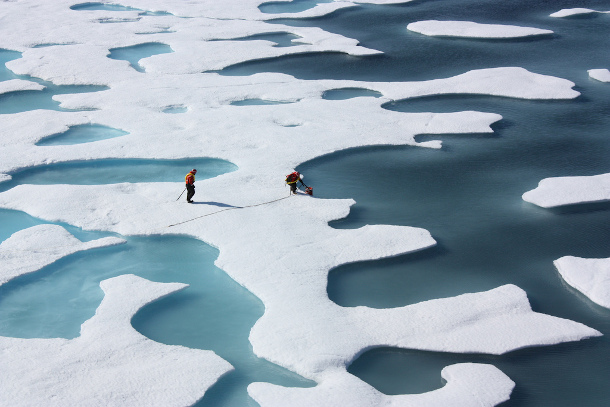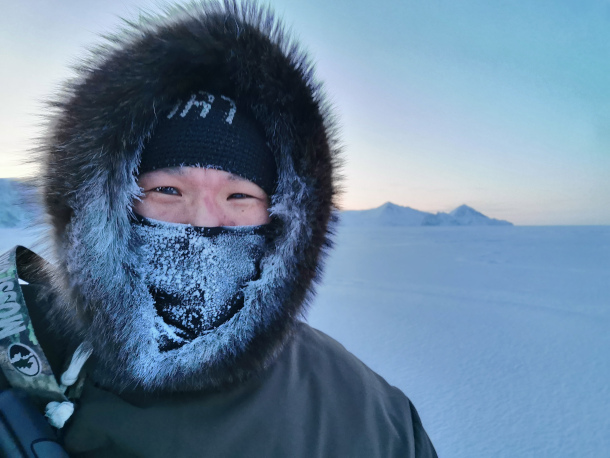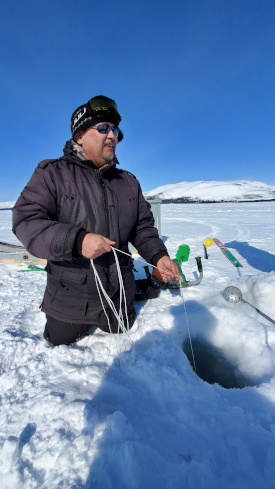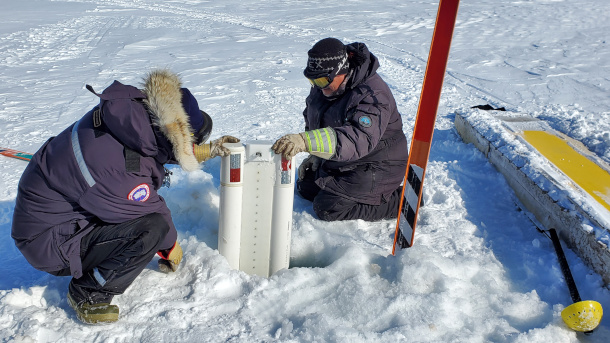“SmartICE” Helps Inuit People Adapt
Air Date: Week of May 13, 2022

The Arctic is warming at a faster rate than the rest of the world. Scientists at the California Institute of Technology and the University of Washington observed that Arctic sea ice thinned 1.5 feet (0.5 meters) between 2018 and 2021. (Photo: Kathryn Hansen, NASA, Flickr, CC BY 2.0)
For thousands of years the Inuit people of Northern Canada have relied on stable sea ice for travel and hunting, but as the climate warms the ice is growing dangerously thin. Now, some Inuit communities are working with SmartICE, an organization that uses sensor and GPS technology along with Inuit traditional knowledge to help find safe passages over sea ice in real time. Rex Holwell is Inuit and the North Production Lead for SmartICE and he joined Host Bobby Bascomb to discuss how this technology is helping communities on the frontlines of climate change.
Transcript
BASCOMB: The Arctic is warming faster than nearly anywhere else on earth, scientists estimate it is warming at roughly twice the rate of lower latitudes. That means the sea ice is increasingly unstable and unpredictable, which makes life in the Arctic difficult for many Inuit people who rely on stable sea ice for travel. Rather than give up and stay home, Inuit communities in Canada’s far north have mobilized for resilience. They developed SmartICE, an innovative technology that uses both stationary buoys and sensors that trail behind a snow mobile to gather data on ice conditions. That data in conjunction with GPS technology can give Inuit travelers information about the ice that can make the difference between life and death. For details I’m joined now by Rex Holwell, he is Inuit and Manager of Nunatsiavut Operations. He joins me now from Nain, the northernmost permanent settlement in the Canadian province of Newfoundland and Labrador where he says the sea ice is crucial for their subsistence.
HOLWELL: A lot of people here rely on seal for the food. A lot of people rely on Arctic char for fishing. And you know, traditionally, like Inuit have always relied on sea creatures to feed them and it's still the case to this day. The sea ice is our highway. If you can imagine if you living in your little community, if you're only able to travel on your main street to the first stop sign, you're pretty limited on where you can travel. For us it's the same way, when we don't have sea ice. You know, when the sea ice finally comes in, it opens up our highway. So when the sea ice freezes inn, and it's nice and safe to travel on, it allows everybody to travel to go to their hunting grounds to go get the seal, to go get the caribou. It gives you the freedom to go to areas that may not be hunted or over harvested. So the sea ice is vital to our culture, not just for hunting, but I mean to be able to go out and to get seals and caribou and to harvest their furs and their skins to make traditional clothing such as seal skin boots and seal skin mitts. It's vital to the Inuit people.
BASCOMB: Now I don't need to tell you that the Arctic is really on the frontlines of climate change. It's warming faster than any other region on Earth by many measures. Can you tell us please about the changes that you've seen on the landscape just in your lifetime?
HOLWELL: One story that I always tell is when I was a young boy in Nain the sea ice would sometimes be freezing in the harbor, sometimes as early as early December. And you know, they would come in and freeze and stayed through the whole year. But now 2021 last year, so last year, it didn't freeze nice and solid and safe enough that people weren't actually traveling on the sea ice till it was almost the end of January. So you know, in my lifespan and from when I was young boy to now, 40 years, I'm seeing that the sea ice is taking a month and a half later to form safely. So we're getting we're seeing it firsthand here. And you know, when the sea ice isn't as thick, a lot of the people can't predict how the sea ice is as reliably as they used to back, you know, 40 years ago, when we had warmer temperatures and a thicker ice. So people who have their traditional knowledge, they're unsure if their traditional knowledge will keep them safe because with climate change, it's making the sea ice so unpredictable, that again, those traditional ways may not be the right way anymore.
BASCOMB: And so if those traditional ways aren't working and the sea ice is coming later, and perhaps even thinning out earlier in the season earlier, you know, towards summer, how does that affect people? I mean, you said that it makes it more difficult to get to their hunting grounds and to travel. But what does that actually mean in a person's day to day life?

Andrew Arreak is Inuit and the Regional Operations Lead for SmartICE in the Qikiqtaaluk Region known as Pond Inlet. (Photo: Courtesy of Rex Holwell)
HOLWELL: So for a lot of people here, you know, in Canada's North, the cost of living is huge. So you know, a good size seal will feed a family for two or three days. But if the sea ice isn't safe enough and that person isn't going out hunting for the seal, you know, they'll have to rely on a store. So just for the cost of say, a tank of gas in your snowmobile and to feed the same family for the two or three meals that one seal would have cost him for the cost of a tank of gas, you know, that's going to cost them three to four times as much to buy the stuff in the store as opposed to being able to go out and harvest that seal to feed their family. Some of the older Inuit people say, you know, I don't feel full when I eat chicken or beef, because I mean, they've grown up eating seal their whole life and it's more nutritionally dense, it has more nutrients, and it's protein rich. So there is some truth to that. You can buy processed foods in the store that are not as healthy as seal meat or caribou meats. So, we're finding with people getting away from their traditional diets to leading them into more health issues in the future.
BASCOMB: Now, I understand that you are working on a really innovative solution to this problem of the ice thinning and coming later in the season and just being so unpredictable. Can you tell us please about SmartICE and the goals that you have with this project?
HOLWELL: So SmartICE was actually founded because of climate change. Back in 2009, here in Nain Labrador where I am, we had rain in January, in 2009 and 2010. In January, in January, in this area, it's supposed to be minus 40.
BASCOMB: Wow.

Rex Holwell is Inuit and the SmartICE Regional Operation Lead for Nunatsiavut. (Photo: Courtesy of Rex Holwell)
HOLWELL: So climate change led to the founding of SmartICE. So what we do here in SmartICE is we are a not for profit social enterprise. And one of the main things that we do is we manufacture a stationary ice measuring sensor that's actually made here in Nain, Labrador. And if you can just really imagine a nine foot long thermometer that measures ice thickness, and this is what the SmartBUOY does. And we have a separate ice measuring center called the SmartQAMUTIK. If you can imagine somebody's towing behind a center on a sled behind a snowmobile and as that person is operating the sensor as they're traveling along, it'll tell them in real time how thick the ice is. So they can travel on the sea ice for you know, as little as 20 minutes or they can go, I just recently went for a ride yesterday that took me eight hours long. And as I'm traveling along on the sea ice, you know it's measuring the sea ice thickness as I'm traveling along. Then when I get back to my home base, it will automatically upload the data into a website where everybody who wants to access this data is free for them to do so. And we try to get the data out to as many people as possible in the community, you know, we'll post it on Facebook, we'll print off images, and we'll put them up into stores and in the post office. You know, a lot of people here in Canada's North don't have phones or internet. So we want to get the data to as many people as possible.
BASCOMB: So just to be clear, if you are out and you have one of these sensors on your snowmobile, you can see in real time, okay, I'm maybe getting to a point that's unsafe, I should turn around. If you don't have one of these sensors, and say you're planning a trip the next day to go out to your hunting grounds or something, you can just go to the local post office and look at a map and say, oh, gosh, I maybe I shouldn't do this right now or plan a different route. Is that basically true?
HOLWELL: Yes, it's just like a GPS. It's just like, you know, people using your phone, it's a tool that they can use to help make informed decisions when you're traveling on the sea ice.

SmartICE members deploying SmartBUOY, a stationary sensor which measures ice thickness and snow using thermistors. (Photo: Hamlin Lampe)
BASCOMB: Tell me more about how would people traditionally assess the ice to make sure it's safe? I mean, I've gone ice skating where you have to get out an axe and you measure how thick is the ice is, but you can't be doing that if you're traveling, you know, hundreds of miles potentially across the ice or maybe not that far. But what are the traditional ways of making sure that the ice is safe?
HOLWELL: So traditional ways? You know, it actually doesn't very much with what you were saying, if you were traveling with your axe. You know, traditionally if Inuit people were traveling on the sea ice they would carry harpoon with them. And we always tell people, you know, if you're traveling long, and you're unsure of the ice, get off your snowmobile, and you take your harpoon. And if you really stabbed the ice really hard, one strike, if it goes through is not safe to walk on. If you have to strike the ice twice, and it doesn't go through, then it's safe for you to walk on. And if you strike the ice three times with the Harpoon, then it's safe for you in the snowmobile. So that's traditionally how they would check the ice. But you know Inuit people were more of an oral history, teaching people. So you know, a lot of the people who went out seal hunting on the sea ice, they learned from their grandfathers, from their fathers, from their uncles. It was just traditional oral history that it was passed on from generation to generation on how to keep safe while they were traveling on the sea ice.

The SmartQAMUTIK, pictured above, is towed behind a snowmobile and provides real-time ice and snow thickness measurements along community trails. SmartQAMUTIK trips are completed at least once per week and data is made available to the community on SIKU.org. (Photo: Lynn Moorman)
BASCOMB: Rex, a lot of what we know about the Arctic ice is from the perspective of oil and gas companies that want to know about shipping routes or scientists that are worried about permafrost and the emissions that can come with it. But SmartICE is really a body of information by and for Native people in the Arctic. These are people who are trying to live their normal lives, while the world is quite literally changing around them right in front of them. What does it mean to you and your community to have this kind of information made by you and for you?
HOLWELL: That's a great question. You know, who better to have handle these technologies and the new learnings and to interpret the data that comes from other agencies, then somebody from your community. So that's one thing that we really believe in, you know, with SmartICE operators, you know, we want the locals to do their routes, because they know where the majority of the people go. So they want to do the routes that will help keep their people safe. One project that we're doing is we're actually using satellite imagery. And we're trying to interpret it into usable maps for the people from the community. Like you mentioned, a lot of these maps that you can find online they're not meant for people in their communities to go to do it or traditional hunts, they're for the ships to go into or pass these communities safely. We're actually hiring on local people, teaching them how to read this data and how to take that data and turn it into something useful that their community can use to help keep them safe while they're traveling on the sea ice.
BASCOMB: Rex Holwell is manager of Manager of Nunatsiavut Operations. Rex, thank you so much for your time today.
HOLWELL: Oh, you're welcome. I was glad to be here and to help spread the story of the Inuit people and what we do with SmartICE.
Links
Bloomberg | “How the Inuit are Reshaping Arctic Climate Science”
Kicker | “SmartICE and Choices for Youth Make Waves in Northern Communities”
Living on Earth wants to hear from you!
Living on Earth
62 Calef Highway, Suite 212
Lee, NH 03861
Telephone: 617-287-4121
E-mail: comments@loe.org
Newsletter [Click here]
Donate to Living on Earth!
Living on Earth is an independent media program and relies entirely on contributions from listeners and institutions supporting public service. Please donate now to preserve an independent environmental voice.
NewsletterLiving on Earth offers a weekly delivery of the show's rundown to your mailbox. Sign up for our newsletter today!
 Sailors For The Sea: Be the change you want to sea.
Sailors For The Sea: Be the change you want to sea.
 The Grantham Foundation for the Protection of the Environment: Committed to protecting and improving the health of the global environment.
The Grantham Foundation for the Protection of the Environment: Committed to protecting and improving the health of the global environment.
 Contribute to Living on Earth and receive, as our gift to you, an archival print of one of Mark Seth Lender's extraordinary wildlife photographs. Follow the link to see Mark's current collection of photographs.
Contribute to Living on Earth and receive, as our gift to you, an archival print of one of Mark Seth Lender's extraordinary wildlife photographs. Follow the link to see Mark's current collection of photographs.
 Buy a signed copy of Mark Seth Lender's book Smeagull the Seagull & support Living on Earth
Buy a signed copy of Mark Seth Lender's book Smeagull the Seagull & support Living on Earth

